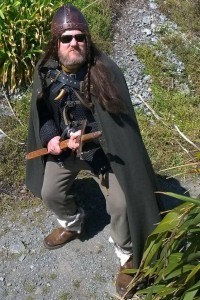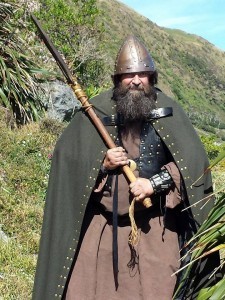Simon J. Cook's Blog, page 15
November 19, 2014
November 13, 2014
Emerging unconscious
November 11, 2014
The Cambridge Mind, 1868-1920
November 5, 2014
What is a Hobbit?
I suppose hobbits need some description nowadays, since they have become rare and shy of the Big People, as they call us. They are (or were) a little people, about half our height…
J.RR. Tolkien, The Hobbit
One day, a few years back, I happened to be reading a forgotten lecture delivered in 1900 to the Anthropological section of the British Association for the Advancement of Science.*
The lecture concerned Welsh folklore and was delivered by the first Oxford Professor of Celtic, John Rhys. Discussing Welsh stories of fairies, or ‘the little people’, Rhys argued that the folk stories passed down the generations in Wales contained dim memories of a very ancient race of people that once dwelt in the British Isles. From the stories Rhys inferred that these people had been:
a small swarthy population of mound-dwellers, of an unwarlike disposition… and living underground.
Turning to archaeology Rhys pointed to the remains of “certain underground — or partially underground — habitations”. He argued that some of these:
dwellings appear from the outside like hillocks covered with grass, so as presumably not to attract attention…. But one of the most remarkable things about them is the fact that the cells or apartments into which they are divided are frequently so small that their inmates must have been of very short stature, like our Welsh fairies. Thus… there must have been a people of that description…
That Tolkien engaged with Rhys there can be no doubt. Rhys was teaching Welsh folklore when Tolkien first went up to Oxford, and the young Tolkien probably attended his lectures on the Mabínogían. And in some of his later scholarly work (see especially ‘The Name Nodens’) Tolkien demonstrates a careful reading of Rhys’s work.
Did Tolkien discover Hobbits in the pages of Rhys’s writing on Welsh fairies?
I think so. And as the release of the third and final installment of The Hobbit movie draws nearer I will revisit this question from time to time on this blog, providing further reasons for believing this to be so, and offering one or two thoughts on its significance in relation to Tolkien’s wider project of creating a mythology for England.
______________________________________________________
*See John Rhys, ‘Presidential Address to Section H. of the BAAS’, Report of the Seventieth Meeting of the British Association for the Advancement of Science, London: John Murray, 1900, pp. 884-896.
Note, with reference to my post of yesterday, that Rhys was not addressing a gathering of students of literature but of anthropology.
November 4, 2014
On disciplinary sin
Here are some implicit assumptions that appear to underpin much current Tolkien studies:
Because Tolkien wrote stories the proper study of his work belongs to students of English literature. What is more, himself a Professor of English, the modern day student of English enjoys privileged access to Tolkien’s life and work.
The purpose of this post is to suggest that these assumptions limit and ultimately stultify our engagement with Tolkien.

Current literary approaches to Tolkien may be compared to this dwarf riding a pig (note the absence of the pig!) Photo: Chris Kaboombee Winchester
In the first instance this is simply to follow in the footsteps of Tom Shippey, who long ago pointed out that Tolkien spent most of his professional life in a protracted disciplinary dispute within English: a civil war in which philologists like himself suffered slow defeat at the hands of the professors of English literature.
Unfortunately, the reception of Shippey’s work lends credence to his complaint about modern English studies. Students with the kind of background in Old English that would allow passage along Shippey’s road to Middle-earth are now few and far between. Consequently, Shippey is hailed as the doyen of Tolkien studies by a generation of English students who proceed to apply to Tolkien’s work just the kind of approach that, according to Shippey, Tolkien loathed.
But Shippey’s presentation of the background to Tolkien’s thought as a conflict between philology and literature is itself overly restricted, unduly confining Tolkien’s work to what has become the discipline of English. We can illustrate this by turning from the green meadows of Tolkien’s Oxford to the windswept fens of Cambridge.
In Edwardian Cambridge much of the scholarship that would have interested Tolkien was conducted within a newly founded faculty of Anthropology. If this sounds weird it is because anthropology has now become the study of ‘primitive others’ but once also included the study of the ‘primitive self’, that is, of the earliest English society and culture.
Cambridge anthropology brought together a number of distinct disciplines, most notably psychology and the study of literature. The original idea around 1900 was that truly primitive people live in a world of myth but that mental and moral progress generates literature. So, for example, the literature of ancient Greece was held to be qualitatively different from the myths of, say, the Torres Straits islanders.
The first decade and a half of the twentieth century saw a concerted effort within Cambridge to identify the culture of the Old North with classical literature as opposed to primitive mythology.
But in the years immediately following World War One the contrast of civilized literature with primitive mythology began to dissolve. The war had shown modern man to be less civilized than he had liked to think while, at the same time, a new interest and respect arose with regard to supposedly primitive art and folklore.
An illustration of the new perspective can be found in F. C. Bartlett‘s 1923 study of Psychology and Primitive Culture, with its crucial chapter on ‘Psychology and the Folk Story’. Much of what Bartlett has to say about the transmission of stories in an oral culture is directly relevant to Tolkien’s meditations upon the pagan culture of the ancient North. And yet, far from being a fellow student of English, Bartlett was the first professor of experimental psychology at Cambridge.
The point is not that Bartlett was an ‘influence’ on Tolkien (whatever that rather nebulous word might mean). The point is that before the Second World War there was no one discipline that could lay claim to the study of mythology – which attracted the learned attention of students of comparative religion, of folklore, anthropologists, psychologists, and students of English. And what any one inquiry had to say was of interest and relevance to all the others.

A real dwarf – but the pig is still nowhere to be seen!
Tolkien believed passionately that the ancient mythology of the English was an intrinsic part of his nation’s cultural heritage.
He sidestepped the dispute over primitive versus civilized culture by refusing to compare the culture of the North with either classical Greece or that of modern day ‘primitives’. He was, however, careful to make clear that the North had been free from ‘savagery’ for time out of mind, thereby pushing the culture of the ancient North towards civilized literature.
In other words, Tolkien believed that while the forgotten stories of the ancient North were not written down, they were nevertheless the proper object of study of a student of English language and culture. But to establish this point of view he had to engage, implicitly or explicitly, with a variety of arguments that were developed outside of English faculties.
All of this points to a basic lesson:
We cannot understand what Tolkien thought he was doing if we see him as simply doing literary theory (or even as engaged in a dispute with students of literature only). Rather, we need to locate Tolkien within a much wider intellectual culture – operating in an academic world not yet fragmented by current disciplinary divisions.
By the same token, we commit a grievous disciplinary sin when we read Tolkien on myth or fairy-stories as addressing himself solely to modern literature. Tolkien was interested in stories, but not only his own and certainly not only modern stories. Tolkien on fairy-stories is a key – to his stories of Middle-earth and also to those ancient myths beyond the reach of song and story but still perceptible to the imagination (indeed, for Tolkien, these were more or less the same thing).
October 26, 2014
Lake Town
If Hobbiton and Rivendell are taken (as intended) to be at about the latitude of Oxford, then Minas Tirith, 600 miles south, is at about the latitude of Florence.
J.R.R. Tolkien in a letter of 1967
Middle-earth, Tolkien insisted, is not an imaginary world; it is our world in an imagined past, since when the land and seas have changed and shifted. But if The Lord of the Rings tells of Hobbits who journey from around the area of Oxford in what was once the Shire all the way to Gondor and Mordor in what is now Southern Europe, where does Bilbo’s adventure take him?
The white line shows the route from Hobbiton in the Shire to Erebor, The Lonely Mountain. If we draw a similar north-eastward trajectory from Oxford on a map of modern Europe we will pass through Angeln on the Baltic coast – which Tolkien took to be the original homeland of the English – and arrive in Zealand, the largest island of modern Denmark, which Tolkien took to be the religious center of the ancient English world.
The Hobbit is a tale of a little Englander who travels to the ancient homeland of the English; a story of a native of the British Isles who has an adventure in the perilous world of ancient English tradition.
In Lake Town we catch a glimpse of the cold Baltic homeland of the English – before they migrated westward and settled down to till the more gentle soil of south-eastern Britain.
This post is dedicated to Chris Kaboombee Winchester, who will soon be appearing as an extra in Peter Jackson’s vision of Lake Town and as star in his own ‘Dwarf on a Pig’ video. Please consider supporting Master Winchester’s comic video productions.
October 18, 2014
October 14, 2014
Tolkien e-essay: preview

Image by Puck
The long tea-break is finally over. But I’ve been drinking the stuff by the barrel of late, working to transform a word document into a publishable electronic essay (an ebook, it turns out, is a kind of glorified html webpage). Tomorrow morning I will give a last read-over hunting out any remaining typos – which are as ubiquitous and as annoying as the mosquitoes that still lurk on my walls here in Luzit. Then I’ll upload to Amazon and, if God is willing, you can purchase the essay for direct download when you wake up this Thursday, October 17 (for the low price of $2.99).
Update: after a day of intense proof-reading and head-hurting technical hurdles, the essay is now live on Amazon (click the image). More soon, after some much needed sleep…
Update: first day: woke up with terrible cold and discover a bug in the html generates an embarrassing error on the table of contents provided in the free Amazon sample – fixed, uploaded again. Back to bed. O, and 8 copies of the book appear to have been sold. If I had a plate of scones I would hand them out to each of these discerning customers.
September 24, 2014
Have a Cuppa Tea
Happy New Year
the Kinks (also from Muswell Hill), 1972





